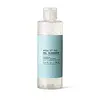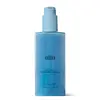What's inside
What's inside
 Key Ingredients
Key Ingredients

 Benefits
Benefits

 Ingredients Side-by-side
Ingredients Side-by-side

Water
Skin ConditioningCoco-Glucoside
CleansingSodium Lauroyl Sarcosinate
CleansingXanthan Gum
EmulsifyingCeramide AP
Skin ConditioningCeramide NP
Skin ConditioningCeramide Ns
Skin ConditioningCeramide EOP
Skin ConditioningRosa Centifolia Flower Water
Skin ConditioningTocopherol
AntioxidantSodium Cocoyl Apple Amino Acids
Skin ConditioningFucus Vesiculosus Extract
EmollientSodium Benzoate
MaskingCitric Acid
BufferingCeteareth-25
CleansingCetyl Alcohol
EmollientBehenic Acid
CleansingCholesterol
EmollientCaprooyl Phytosphingosine
Skin ConditioningCaprooyl Sphingosine
Skin ConditioningHexylene Glycol
EmulsifyingTetrasodium Glutamate Diacetate
Potassium Sorbate
PreservativeEthylhexylglycerin
Skin ConditioningPhenoxyethanol
PreservativeAscorbyl Palmitate
AntioxidantWater, Coco-Glucoside, Sodium Lauroyl Sarcosinate, Xanthan Gum, Ceramide AP, Ceramide NP, Ceramide Ns, Ceramide EOP, Rosa Centifolia Flower Water, Tocopherol, Sodium Cocoyl Apple Amino Acids, Fucus Vesiculosus Extract, Sodium Benzoate, Citric Acid, Ceteareth-25, Cetyl Alcohol, Behenic Acid, Cholesterol, Caprooyl Phytosphingosine, Caprooyl Sphingosine, Hexylene Glycol, Tetrasodium Glutamate Diacetate, Potassium Sorbate, Ethylhexylglycerin, Phenoxyethanol, Ascorbyl Palmitate
Water
Skin ConditioningGlycerin
HumectantAloe Barbadensis Leaf Juice
Skin ConditioningSodium Cocoyl Isethionate
CleansingCocamidopropyl Hydroxysultaine
CleansingSodium Methyl Cocoyl Taurate
CleansingVaccinium Angustifolium Fruit Extract
Skin ProtectingRubus Idaeus Fruit Extract
AstringentPyrus Malus Fruit Extract
Skin ConditioningCucumis Sativus Fruit Extract
EmollientPanthenol
Skin ConditioningSpirodela Polyrhiza Extract
Skin ConditioningSodium Hyaluronate
HumectantHydrolyzed Gardenia Florida Extract
AntioxidantSodium Hyaluronate Crosspolymer
HumectantHydrolyzed Sodium Hyaluronate
Skin ConditioningSodium Acetylated Hyaluronate
HumectantAcrylates Copolymer
Maltodextrin
AbsorbentPentylene Glycol
Skin ConditioningSodium Benzotriazolyl Butylphenol Sulfonate
UV AbsorberDisodium EDTA
Phenoxyethanol
PreservativeEthylhexylglycerin
Skin ConditioningPotassium Sorbate
PreservativeSodium Benzoate
MaskingCitric Acid
BufferingSodium Hydroxide
BufferingWater, Glycerin, Aloe Barbadensis Leaf Juice, Sodium Cocoyl Isethionate, Cocamidopropyl Hydroxysultaine, Sodium Methyl Cocoyl Taurate, Vaccinium Angustifolium Fruit Extract, Rubus Idaeus Fruit Extract, Pyrus Malus Fruit Extract, Cucumis Sativus Fruit Extract, Panthenol, Spirodela Polyrhiza Extract, Sodium Hyaluronate, Hydrolyzed Gardenia Florida Extract, Sodium Hyaluronate Crosspolymer, Hydrolyzed Sodium Hyaluronate, Sodium Acetylated Hyaluronate, Acrylates Copolymer, Maltodextrin, Pentylene Glycol, Sodium Benzotriazolyl Butylphenol Sulfonate, Disodium EDTA, Phenoxyethanol, Ethylhexylglycerin, Potassium Sorbate, Sodium Benzoate, Citric Acid, Sodium Hydroxide
 Reviews
Reviews

Ingredients Explained
These ingredients are found in both products.
Ingredients higher up in an ingredient list are typically present in a larger amount.
Citric Acid is an alpha hydroxy acid (AHA) naturally found in citrus fruits like oranges, lemons, and limes.
Like other AHAs, citric acid can exfoliate skin by breaking down the bonds that hold dead skin cells together. This helps reveal smoother and brighter skin underneath.
However, this exfoliating effect only happens at high concentrations (20%) which can be hard to find in cosmetic products.
Due to this, citric acid is usually included in small amounts as a pH adjuster. This helps keep products slightly more acidic and compatible with skin's natural pH.
In skincare formulas, citric acid can:
While it can provide some skin benefits, research shows lactic acid and glycolic acid are generally more effective and less irritating exfoliants.
Most citric acid used in skincare today is made by fermenting sugars (usually from molasses). This synthetic version is identical to the natural citrus form but easier to stabilize and use in formulations.
Read more about some other popular AHA's here:
Learn more about Citric AcidEthylhexylglycerin (we can't pronounce this either) is commonly used as a preservative and skin softener. It is derived from glyceryl.
You might see Ethylhexylglycerin often paired with other preservatives such as phenoxyethanol. Ethylhexylglycerin has been found to increase the effectiveness of these other preservatives.
Phenoxyethanol is a preservative that has germicide, antimicrobial, and aromatic properties. Studies show that phenoxyethanol can prevent microbial growth. By itself, it has a scent that is similar to that of a rose.
It's often used in formulations along with Caprylyl Glycol to preserve the shelf life of products.
Potassium Sorbate is a preservative used to prevent yeast and mold in products. It is commonly found in both cosmetic and food products.
This ingredient comes from potassium salt derived from sorbic acid. Sorbic acid is a natural antibiotic and effective against fungus.
Both potassium sorbate and sorbic acid can be found in baked goods, cheeses, dried meats, dried fruit, ice cream, pickles, wine, yogurt, and more.
You'll often find this ingredient used with other preservatives.
Learn more about Potassium SorbateSodium Benzoate is a preservative. It's used in both cosmetic and food products to inhibit the growth of mold and bacteria. It is typically produced synthetically.
Both the US FDA and EU Health Committee have approved the use of sodium benzoate. In the US, levels of 0.1% (of the total product) are allowed.
Sodium benzoate works as a preservative by inhibiting the growth of bacteria inside of cells. It prevents the cell from fermenting a type of sugar using an enzyme called phosphofructokinase.
It is the salt of benzoic acid. Foods containing sodium benzoate include soda, salad dressings, condiments, fruit juices, wines, and snack foods.
Studies for using ascorbic acid and sodium benzoate in cosmetics are lacking, especially in skincare routines with multiple steps.
We always recommend speaking with a professional, such as a dermatologist, if you have any concerns.
Learn more about Sodium BenzoateWater. It's the most common cosmetic ingredient of all. You'll usually see it at the top of ingredient lists, meaning that it makes up the largest part of the product.
So why is it so popular? Water most often acts as a solvent - this means that it helps dissolve other ingredients into the formulation.
You'll also recognize water as that liquid we all need to stay alive. If you see this, drink a glass of water. Stay hydrated!
Learn more about Water